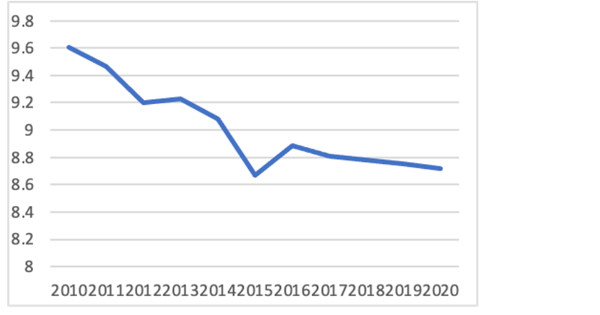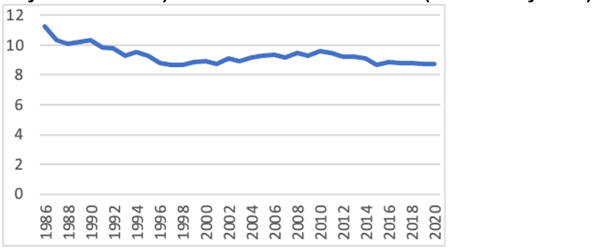New Zealanders Follow Global Trend Of Drinking Less Alcohol
The NZ Alcohol Beverages Council (NZABC) says declining alcohol consumption in New Zealand is a trend seen globally, even with an ongoing pandemic. The International Alliance for Responsible Drinking (IARD), of which NZABC is a member, found new data from over 100 countries shows consumers worldwide bought 15.8 billion fewer litres of alcohol beverages in the past year.[i] Lockdowns, closure of hospitality venues, and restrictions on socialising with friends and family contributed to alcohol sales volumes declining by more than 6%, but studies have also shown people are choosing to drink less.
New Zealand government data shows a similar decline, with alcohol available for consumption at 8.719 litres of alcohol available per head of population in December 2020 compared to 8.752 litres in December 2019.[ii]
“The global decline in consumption has been brought about by impacts on how we can socialise during the pandemic, but also people making better drinking decisions based on their personal circumstances and lifestyle. The pandemic has been a reason for people world-over to think about their alcohol consumption and health and wellbeing. The majority of New Zealanders drink moderately and responsibly. Still, it’s always good to check that our consumption of alcohol is part of a balanced lifestyle,” said Bridget MacDonald, NZABC’s Executive Director.
Over lockdown, over one-third (36%) of New Zealanders didn’t drink at all, one-third (34%) were drinking less, and nearly half (47%) consumed about the same. Post-lockdown saw drinking habits return to pre-lockdown levels for most New Zealanders, with two-thirds (64%) drinking at their usual (pre-lockdown) levels and 22% reporting they were drinking less than usual. The number of everyday drinkers also declined. [iii] Similar patterns were found globally, with well over 80% of drinkers consuming the same amount or less.[iv]
“There’s a shift in social attitudes toward alcohol, with consumers choosing more no- and low-alcohol options. Industry research showing 40% of people choose to drink low-alcohol beverages,” Bridget says. [v]
“Momentum for change toward moderation is gaining through positive trends such as a general decline in hazardous drinking, fewer younger people drinking, consumption decreasing, and per capita, we consume less alcohol than the OECD average,” Bridget says. [vi][vii]
“There is still room for improvement when it comes to one in five people drinking harmfully in the past year. That’s a global issue, and it’s not okay. We need an all-of-society approach with public and private sectors working together to accelerate the positive trends. Still, we also need to take a pragmatic approach to reduce harmful drinking – targeted education programmes are sensible solutions to helping educate young people on alcohol harm and encouraging adults to make better decisions around drinking, as well as targeted help and support for those who need it most,” Bridget says.
[i]Euromonitor International Proprietary Alcoholic Drinks data
| Top twenty markets by alcohol sales volume Market | Global alcohol sales volume year-on-year growth 2019-2020 |
| China | -8.5% |
| USA | -0.6% |
| Brazil | 4.1% |
| Germany | -5.2% |
| Russia | 1.7% |
| Mexico | -7.2% |
| Japan | -5.9% |
| United Kingdom | -10.1% |
| India | -19.0% |
| Spain | -14.4% |
| France | -8.0% |
| Vietnam | -14.0% |
| Poland | -5.9% |
| Italy | -8.5% |
| South Korea | 0.4% |
| South Africa | -20.4% |
| Canada | 0.4% |
| Argentina | 2.7% |
| Australia | 1.3% |
| Thailand | -9.3% |
[ii] Decreasing alcohol consumption: StatsNZ Infoshare, Alcohol available for consumption to December 2020 (published 25 February 2021), http://archive.stats.govt.nz/infoshare/.
Alcohol available for consumption has been trending downward for a number of years. Data shows alcohol available for consumption was 8.719 litres per head of population (15 years and older) in December 2020 and 9.607 litres in 2010, resulting in a 9.2% decrease (see graph 1 below). There has been a 15.4% decrease since 1990 when it was 10.316 litres, and a 22.7% decrease since 1986 when the data was first collected where there was 11.282 litres per head of population (15 years and older) in December 2020 (see graph 2 below). The per head of population (15 years and older) is the measure used by the OECD.
Graph 1. Litres of Alcohol Per Head of Population in New Zealand (Annual-December, 2010-2020, 15 years and over) Source: Stats NZ Infoshare (February 2021)

Graph 2. Litres of Alcohol Per Head of Population in New Zealand (Annual-December 1986-2020, 15 years and over) Source: Stats NZ Infoshare (25 February 2021)

NZ consumption below OECD average: OECD Alcohol Consumption, https://data.oecd.org/healthrisk/alcohol-consumption.htm. Alcohol consumption is defined as annual sales of pure alcohol in litres per person aged 15 years and older. The OECD average consumption is 8.9 litres/capita (aged 15 and over). New Zealand is at 8.8 litres/capita. See graph 3 below. Source: OECD Health Statistics, 2019. New Zealand figures as at 2018.
[iii] Health Promotion Agency research on consumption over lockdown in NZ: https://www.hpa.org.nz/research-library/research-publications/the-impact-of-lockdown-on-health-risk-behaviours
Health Promotion Agency, Post-lockdown survey - the impact on health risk behaviours, 28 July 2020 https://www.hpa.org.nz/research-library/research-publications/post-lockdown-survey-the-impact-on-health-risk-behaviours
New Zealand Health Survey 2019/20, November 2020, https://www.health.govt.nz/publication/annual-update-key-results-2019-20-new-zealand-health-survey Four in five adults (81.5%) drank alcohol in the past year and are moderate drinkers. One in five drank (20.9%) in a hazardous way.
[iv] Global consumption over lockdowns: YouGov for IARD in May 2020 and November 2020 that found that 84% and 86% of drinkers were consuming the same amount or less alcohol during shutdowns.
[v] No- and low-alcohol consumption: NZ Alcohol Beverages Council, New Zealander’s attitudes to alcohol, December 2020, poll of 1000 New Zealanders: Do you drink low-alcohol beverages, and if so have you consumed more or less in the past year compared to 12 months ago? 40% of respondents say they drink low-alcohol beverages. 25% say they are drinking the same amount of low-alcohol beverages, 8% more and 8% less than a year ago. The most common reasons for drinking low-alcohol beverages were preference (22%), health (18%) and driving (17%).
[vi] Decreasing alcohol consumption: StatsNZ Infoshare, Alcohol available for consumption to December 2020 (published 25 February 2021), http://archive.stats.govt.nz/infoshare/.
Alcohol available for consumption has been trending downward for a number of years. Data shows alcohol available for consumption was 8.719 litres per head of population (15 years and older) in December 2020 and 9.607 litres in 2010, resulting in a 9.2% decrease (see graph 1 below). There has been a 15.4% decrease since 1990 when it was 10.316 litres, and a 22.7% decrease since 1986 when the data was first collected where there was 11.282 litres per head of population (15 years and older) in December 2020 (see graph 2 below). Note: The per head of population (15 years and older) is the measure used by the OECD.


 Yachting New Zealand: NZ Windfoil Star Starts New Olympic Campaign With Bronze At Princess Sofia
Yachting New Zealand: NZ Windfoil Star Starts New Olympic Campaign With Bronze At Princess Sofia E tū: Bupa Roster Changes Put Residents And Caregivers At Risk
E tū: Bupa Roster Changes Put Residents And Caregivers At Risk Democratic Voice of Burma: The Resilience And Hope Of Myanmar’s People On Screen In Auckland Sat April 5
Democratic Voice of Burma: The Resilience And Hope Of Myanmar’s People On Screen In Auckland Sat April 5 NZSEG: Powering The Future - NZSE College And Royal New Zealand Navy Forge Educational Partnership
NZSEG: Powering The Future - NZSE College And Royal New Zealand Navy Forge Educational Partnership Courtney Duncan: Illness Prevents Duncan From Contesting First Round Of 2025 World Women’s Motocross Championship
Courtney Duncan: Illness Prevents Duncan From Contesting First Round Of 2025 World Women’s Motocross Championship GPNZ: Extended Skill Mix In Primary Care Teams Improves Patient Access And Outcomes
GPNZ: Extended Skill Mix In Primary Care Teams Improves Patient Access And Outcomes